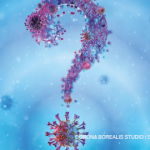 ACR CONVERGENCE 2021—Rheumatology patients who test positive for COVID-19 would benefit from early use of monoclonal antibodies, said Luis Ostrosky-Zeichner, MD, chief of the Division of Infectious Diseases, McGovern Medical School, University of Texas Health Science Center (UTHealth), Houston, in a session about effective treatment options for COVID-19.
ACR CONVERGENCE 2021—Rheumatology patients who test positive for COVID-19 would benefit from early use of monoclonal antibodies, said Luis Ostrosky-Zeichner, MD, chief of the Division of Infectious Diseases, McGovern Medical School, University of Texas Health Science Center (UTHealth), Houston, in a session about effective treatment options for COVID-19.

Dr. Ostrosky-Zeichner; Photo by Dwight C. Andrews/McGovern Medical School at UTHealth Office of Communications
Acknowledging that the SARS-CoV-2 virus has already killed millions of people worldwide, Dr. Ostrosky-Zeichner said, “This is a history-changing pandemic.” Scientists have learned a great deal about SARS-CoV-2 over the past two years, and this growing body of knowledge has helped contain the spread of the virus and save lives.
About the Virus
Public health officials now know, for example, that the virus has a 2–14-day incubation period, and although there is some long-term shedding of the virus, patients are not infectious beyond 10–20 days. Asymptomatic patients can, however, spread the virus.
SARS-CoV-2 is spread person-to-person via droplets, which makes it less transmissible than it would be if it were truly airborne. Its maximum environmental survival is two to four days, but surfaces are not a common route of transmission. Moreover, it is susceptible to common disinfectants.
According to Dr. Ostrosky-Zeichner, people who have underlying medical conditions, including cancer and chronic kidney or lung disease, are immunocompromised, and the elderly have a higher incidence of mortality from COVID-19. Racial and ethnic minorities also have a higher risk of mortality.
The good news: Vaccines are highly effective in preventing infection from most variants, as are masking and social distancing. Moreover, early therapy improves outcomes.
Dr. Ostrosky-Zeichner explained that experts still have a great deal to learn about relapse, reinfection, immunity and variants. “Currently, the CDC [the Centers for Disease Control and Prevention] does not recommend making any clinical decisions based on antibodies,” he said.
Dr. Ostrosky-Zeichner next presented a 2020 paper from the CDC that proposed a framework and timeline related to the spectrum of disease due to SARS-CoV-2.1 The paper described how COVID-19 morbidity includes an acute infection phase, post-acute hyperinflammatory illness and late sequelae. The three stages describe the temporal course of SARS-CoV-2 infection at the population level, as well as distinct phases of host viral interactions. Individuals may experience any combination of these phases or have an asymptomatic infection.
“The severity of illness is very acute initially,” explained Dr. Ostrosky-Zeichner. The first phase is the best characterized of the three illness periods, and patients often experience cough, fever and dyspnea. Some adults and children go on to experience a rare, multi-system inflammatory illness that includes prominent cardiovascular and gastrointestinal manifestations.2



